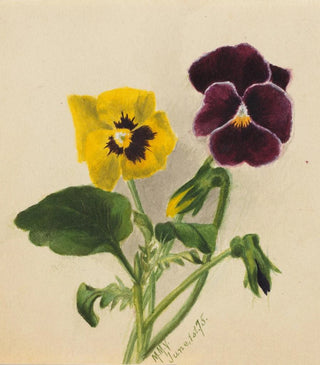Art print | Pensées 2 - Mary Vaux Walcott


View from behind

Frame (optional)
In the world of art, some works manage to capture the very essence of nature with such finesse that they transcend their era. "Pensées 2 - Mary Vaux Walcott" is one of these creations. This piece, imbued with delicacy and poetry, invites us to delve into a universe where floral beauty blends with a profound reflection on human nature. The meticulous depiction of thoughts, with their vibrant colors and graceful forms, transports us to a secret garden, where each petal seems to whisper forgotten stories. It is an invitation to contemplate, breathe, and feel, all while being enveloped by the softness of the hues.
Style and uniqueness of the work
Mary Vaux Walcott's work stands out for its naturalistic approach, where every detail is treated with almost scientific precision. In "Pensées 2," she manages to capture not only the appearance of the flowers but also their essence, character, and symbolism. The shades of color, ranging from deep violets to bright whites, create a visual harmony that delights the eye. The composition is carefully balanced, with each flower occupying a strategic position that enhances the overall. This unique style, combining botanical accuracy with artistic sensitivity, reflects her deep respect for nature. Walcott does not merely depict flowers; she elevates them to the rank of art pieces, prompting us to reconsider our relationship with the flora that surrounds us.
The artist and her influence
Mary Vaux Walcott, artist and botanist, skillfully combined her two passions to create a body of work that continues to inspire future generations. Her commitment to preserving nature and her ability to translate its beauty onto canvas make her an emblematic figure of the early 20th century. She not only contributed to documenting American flora but also paved the way for a new approach to floral art. By integrating scientific elements into her work, she broadened the horizons of botanical art, thus creating a bridge between art and nature. Her influence endures, resonating in the work of contemporary artists.

Matte finish

View from behind

Frame (optional)
In the world of art, some works manage to capture the very essence of nature with such finesse that they transcend their era. "Pensées 2 - Mary Vaux Walcott" is one of these creations. This piece, imbued with delicacy and poetry, invites us to delve into a universe where floral beauty blends with a profound reflection on human nature. The meticulous depiction of thoughts, with their vibrant colors and graceful forms, transports us to a secret garden, where each petal seems to whisper forgotten stories. It is an invitation to contemplate, breathe, and feel, all while being enveloped by the softness of the hues.
Style and uniqueness of the work
Mary Vaux Walcott's work stands out for its naturalistic approach, where every detail is treated with almost scientific precision. In "Pensées 2," she manages to capture not only the appearance of the flowers but also their essence, character, and symbolism. The shades of color, ranging from deep violets to bright whites, create a visual harmony that delights the eye. The composition is carefully balanced, with each flower occupying a strategic position that enhances the overall. This unique style, combining botanical accuracy with artistic sensitivity, reflects her deep respect for nature. Walcott does not merely depict flowers; she elevates them to the rank of art pieces, prompting us to reconsider our relationship with the flora that surrounds us.
The artist and her influence
Mary Vaux Walcott, artist and botanist, skillfully combined her two passions to create a body of work that continues to inspire future generations. Her commitment to preserving nature and her ability to translate its beauty onto canvas make her an emblematic figure of the early 20th century. She not only contributed to documenting American flora but also paved the way for a new approach to floral art. By integrating scientific elements into her work, she broadened the horizons of botanical art, thus creating a bridge between art and nature. Her influence endures, resonating in the work of contemporary artists.






